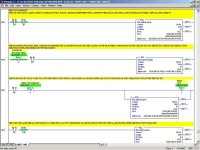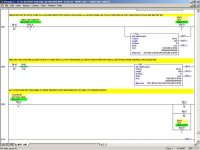Thanks Guys
I have attached code I got from another thread on here, which looks to be doing the same thing, an OR and then a NEQ.
Again I would just like to see it as bits now as oppose to words. In this example it mentions alarm state(b219) = 0, so B219=1 is good, im not sure what B220 initial state should be?
Lets say it is also a 1, then as soon as we get an alarm (b219 = 0) then B220 would stay a 1 (0 or 1 = 1) and nothing would change.


I have attached code I got from another thread on here, which looks to be doing the same thing, an OR and then a NEQ.
Again I would just like to see it as bits now as oppose to words. In this example it mentions alarm state(b219) = 0, so B219=1 is good, im not sure what B220 initial state should be?
Lets say it is also a 1, then as soon as we get an alarm (b219 = 0) then B220 would stay a 1 (0 or 1 = 1) and nothing would change.





